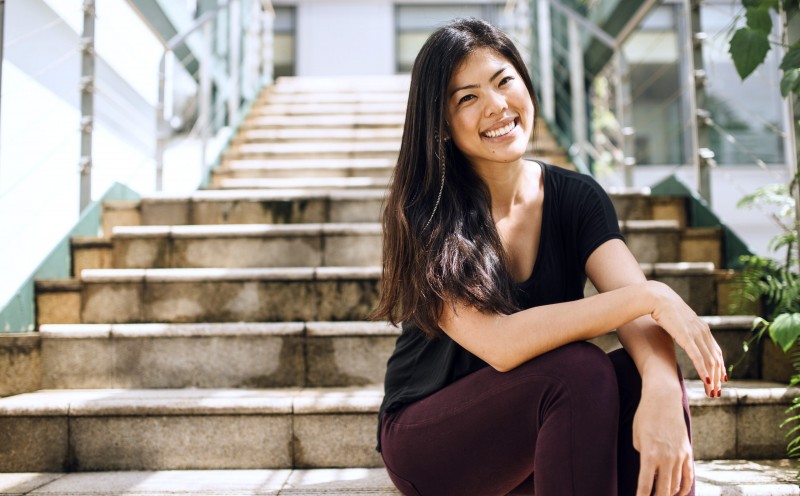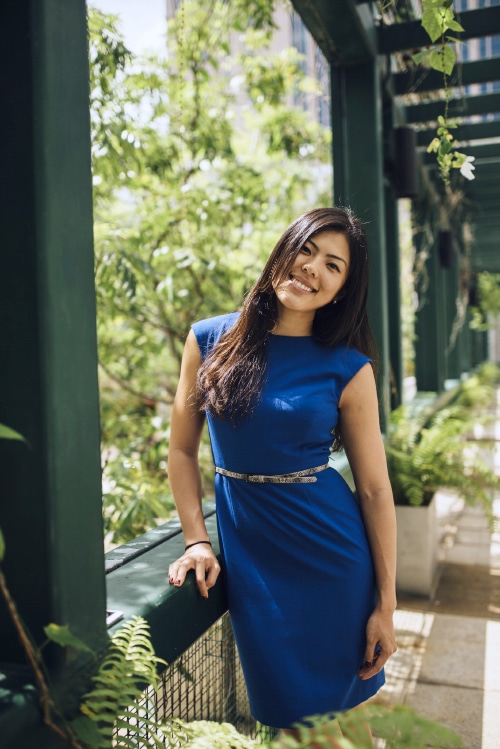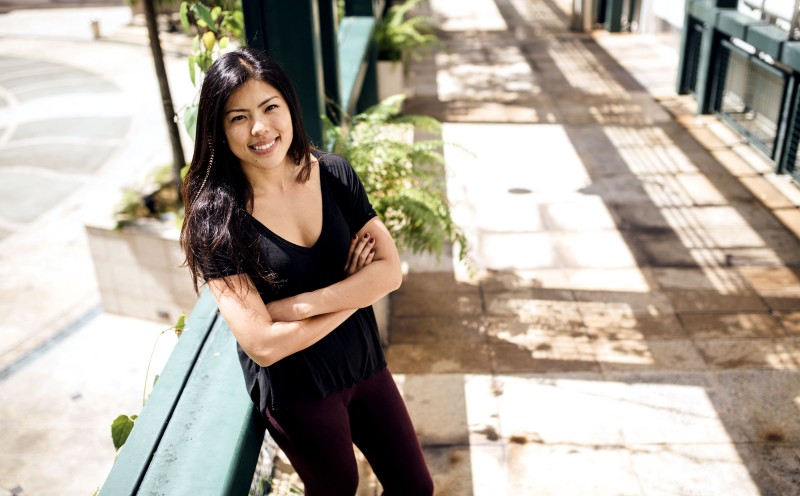Mina Lee: A Divine Spirit

There have been three formative shifts in Mina Lee’s life before she started working for Xiaomi in September 2014. The first was taking part in NYU’s international business exchange programme, which brought her to Singapore to learn more about the Kyoto Protocol and Clean Development Mechanism. The second was joining Boston Consulting Group to pursue her passion and follow developments in the clean-energy sector, but ending up managing palm oil projects – a far cry from what she had set out to do originally. And the third – and quite possibly the biggest pivot of all – was starting an events company in New York that leveraged on the Summit Series network to organise prominent dialogue sessions, where she arrived at the epiphany that being an entrepreneur for the sake of owning a business, without making any impact on society and the world, is meaningless.
“Success, to me, is all about impact,” Mina says, oozing bonhomie. “And I want to leave a positive imprint on the world.” Her soulful doe eyes lined with just the right amount of kohl sparkle with idealism. Any form of skepticism towards such lofty, altruistic claims quickly dissipates as she proceeds to win me over with her indefatigable charisma and genuineness. “This year and last year have been channelled towards a lot of spiritual development and self-growth, and letting go of things which no longer serve me.”
More often than not, many find their identity and purpose in life overshadowed by monetary pursuits and the quest for status and recognition. Mina defies the mould of the typical, arriviste corporate warrior who desires rapid advancement and instant gratification. “I have always wanted to do something in tech, but with a long term environmental conservation goal. Hopefully, through the use of data analytics tools, more solutions can be developed to protect the rainforest and wildlife. I’m keeping a watchful eye on that space.”
At the moment, her aspirations will have to wait, however, as this garrulous and engaging ‘Child of the Universe’ has a lot on her plate. Tasked with managing the growth and expansion of Xiaomi in Southeast Asia, Mina has to travel frequently and juggle multiple roles – strategy, operations, marketing, supply chain management, and recruitment.
It’s just after 2pm, and Mina hasn’t had lunch yet. “Do you mind if I eat during the interview?” she asks, unabashedly, before tucking into her noodles from DoSiRak.
WY-LENE YAP: How did you end up at Xiaomi?
MINA LEE: Before I joined, I was in talks with Tesla and Spotify, but I was also really interested in Xiaomi because there has never been one Chinese company that has managed to go global with their brand. There are companies like Lenovo, Huawei… but they don’t send a clear message about what they believe in or stand for.
WY-LENE: What about Alibaba?
MINA: Alibaba is very impressive, and I think there is a lot of excitement surrounding them because they are in a market that is projected to grow at a rapid pace. However, personally, your mission statement needs to be in sync with your belief statement – and I’m echoing what Simon Sinek (he has a very famous TED talk) shared before. When someone asks you what your company does, you don’t tell them what you’re doing, you tell them why. Xiaomi had a very strong “why” statement, and were clear about what they wanted to achieve. In addition, there were a lot of interesting elements around the hardware and software components which might be challenging to roll out simultaneously, and that appealed to me. Through my network, I heard they were looking for a global chief of staff in Beijing, so I started speaking to Hugo [Barra]. However, I didn’t spend considerable time growing up China so I wasn’t a good fit for that role. Coincidentally, they needed someone for Southeast Asia, and that’s how I ended up in Singapore.
WY-LENE: You don’t speak Mandarin?
MINA: I speak fluent Mandarin, but I didn’t grow up in China. I moved to the US at the age of 4. Hence, I’m not that familiar with Chinese consumer preferences and top apps or current trends.
When I was at BCG, getting the right analysis was crucial, and it involved triangulating the data to obtain optimal inputs. But now at Xiaomi, I learnt how to make the best decision with imperfect data.
WY-LENE: How’s it like working at Xiaomi?
MINA: You know what they say about start-ups? It really feels like dog years. [laughs] When I first joined, Hugo told me that my scope would expand soon. When we met in February, he said, “See… less than 6 months, what did I predict?” It’s been an amazing and fun journey. Yet, it’s chaotic at the same time. When I was at BCG, getting the right analysis was crucial, and it involved triangulating the data to obtain optimal inputs. But now at Xiaomi, I learnt how to make the best decision with imperfect data. You need to move fast. So the question becomes how do I make the best decision I can given limited data and time, and minimise the risks? It’s definitely a much more operational role: like rolling out more than 100 kiosks in retail stores (retail operations was definitely new for me), choosing our payment channel provider in Indonesia, and hiring and managing on the ground promoters and sales people.
WY-LENE: It’s interesting how you use the word “start-up”. Correct me if I’m wrong, but Xiaomi is the world’s third largest smartphone distributor.
MINA: Our China business is much more established as compared to our global business. In fact, our global business has only been in existence for a year and a half – it’s still very new. We do get a lot of functional support from China for warehouses, operations, etc. In February 2014, we entered into Singapore and subsequently, in other markets towards the middle and tail end of 2014. When I joined the global team, there were less than 50 people, and now we have multiplied our staff strength many times because we have been growing our operations in India, Brazil and Indonesia. Part of this growth process means that we’re still building the team, and setting up foundational organisational structures and processes. We probably have more than 15 people in Brazil, more than 25 in India, and more than 25 in Southeast Asia.
WY-LENE: Why was Singapore chosen as the international headquarters?
MINA: Singapore was our first overseas market and geographically, it is a good hub for China and India. Furthermore, the Singapore government is very supportive of multinationals setting up their headquarters here.
WY-LENE: Yes, Temasek invested…
MINA: Ah, you did your homework. And we are also trying to create a centre of logistics excellence in Singapore. We try to support the larger innovation ecosystem in the markets we are present in.
WY-LENE: Let’s talk more about your job scope in greater detail.
MINA: It includes everything from setting the price for our products, analysing the competitor landscape, business intelligence, hiring staff, supporting international expansion plans, to launching our Indonesia business. The last has taken up most of my time lately – structuring our legal entity, negotiating commercial contracts, on-boarding strategic partners such as banks and operators, and finally, launching our mi.com/id in Q2. Basically, I handle all the in-market and front-end work, while my partner-in-crime in Beijing helps with the back-end operations.
WY-LENE: What’s the most important skill set that is required in your current role?
MINA: The ability to do everything well! [laughs] I’m kidding. It’s probably the ability to multi-task and prioritise what is important. Recognising the need to stay calm is also crucial. Everything is urgent, but everything will also be okay if we don’t get it done today. Let’s not have a panic attack.
WY-LENE: How many people are under you?
MINA: We’re a very flat organisation – I oversee business intelligence and the Indonesia team now as Acting GM but that can change with my scope of work. Mostly, I coordinate and work alongside everyone.
WY-LENE: How big is the Singapore office?
MINA: We probably have more than 20 people now including PR, finance, admin, logistics, social media, and product testing.
WY-LENE: How is the hiring process like?
MINA: It can be tough. Hugo prefers to speak to our candidates. For Southeast Asia, they typically go through me, Steve [Vickers] who is the General Manager for Southeast Asia, and Hugo. Depending on which functional position they are in, we will also forward the candidate to the relevant functional manager in Beijing. We are very lean, so we need to ensure that the people we hire are a good fit – not everyone is suitable for the ‘start-up life’.
If we spent marketing dollars like other OEMs, our phones would be a lot more expensive.
WY-LENE: You have to be able to deal with uncertainty.
MINA: Yeah, and we don’t have a lot marketing money to throw around unlike other companies. If we spent marketing dollars like other OEMs, our phones would be a lot more expensive. Hence, we need to operate in a lean manner to deliver our value proposition.
WY-LENE: Can you tell me more about the company culture?
MINA: We work very hard.
WY-LENE: Is it like a “10-to-10” schedule which Lei Jun has established?
MINA: Our China office works from 10 in the morning to 10 at night. Over here, we are always on the road, and I travel 2 to 3 days every single week. It’s harder to get that kind of face time. Furthermore, we are a smaller outfit, so as long as you get the work done, it’s up to the individual. The office culture is fun – sometimes on Fridays, we invite Xiaomi fans to come over, and we have pizza with them. The last time Hugo was here, we invited 15 people to test the Mi 4i. They did a butt test and everyone sat on the phone to see how durable it was. I also did a headstand on the phone because I do a lot of yoga. These activities happen all the time, as we are a very social media-driven company.
WY-LENE: What’s the first thing you do when you wake up? Check your phone?
MINA: I check my phone and make sure there is nothing urgent. Then, I do 20 to 30 minutes of meditation. I think it’s really important to have that mental awareness of your own stress levels and control when you’re dealing with so many different things.
WY-LENE: How many Xiaomi phones do you have?
MINA: 5 or 6.
WY-LENE: Will you lose your job if you’re caught with a Samsung or Apple phone?
MINA: [laughs] No, I don’t think so. Actually, we test out different phones for competitor analysis – especially our product guys. In general, people who work at Xiaomi are big fans of the company, and we use the phones because we want to give feedback too.
WY-LENE: Did you use an iPhone before?
MINA: Yeah, the iPhone is a beautiful phone, and I think it is still one of the best phones out there.
WY-LENE: I have to agree with you because I have an iPhone.
MINA: What’s different about Xiaomi that amazes me, is the cult following and fan mentality that we have. On my last trip to China, as I walked past our Mi Home (retail outlet), I saw many people who were non-Xiaomi staff delivering food and helping us set up the space. So I asked my colleague: who are those people? And he said, “Those are Mi Fans.” I replied: why are they doing that? His response was, “That’s because they feel like they own the product and they are part of Xiaomi.” It was a mind-blowing moment. Our software gets updated every Friday, and the Mi Fan community can give suggestions to the build. It’s like gamification – if you’re really good, you get access to the weekly build, and if you hit all the KPIs, you get access to the daily build.
WY-LENE: Are you referring to the MIUI (Mi User Interface)?
MINA: Yes, and there are different levels within the community differentiated by people’s commitment level. I think Xiaomi has created a platform for engineers, developers, geeks (we call ourselves that proudly) to come together to form communities. Before that, they were in silos. Now, Xiaomi has brought them together and created an opportunity for them to hang out all the time (we have fan organised events at least once a month in Indonesia for example). In fact, we have a dedicated position whose job is just to respond to Facebook comments and messages in all our international markets. All inboxes have to be cleared. I get emails, our CEO gets emails, Hugo gets emails on customer service complaints… and we do respond to our customers. On top of that, we take a personal interest in listening to them, and it becomes an open dialogue with our buyers. The development process is what sets us apart – when people participate, it gives them a sense of ownership, and this is what I mean when they feel like they own the product. We have a number of secret functions in our phones that might have come from fan suggestions – for example, we have a private messaging function behind the normal messaging screen. If someone in your private messages list sends you a message, it only shows message received – the sender’s identity is not revealed. If your boyfriend or girlfriend checks your phone, they will never see that message.
WY-LENE: This is great for people who have affairs.
MINA: You said it! Not me! [laughs] I’m such a product nerd. We also have a beautify feature which evens out your skin tone. The girls love it, and the guys who didn’t like to take selfies initially, really grow to like them. The MIUI (Xiaomi OS) is easy to use, but difficult to master. And unless you go to the forums, you won’t know all the additional features.
A lot of retailers won’t survive if they are purely brick and mortar... e-commerce is here to stay and will continue to grow more significantly.
WY-LENE: What are some of the key market findings here?
MINA: I think e-commerce is very healthy in Singapore, which is good for us. Singapore is also quite a different market as compared to Malaysia, Indonesia, and Philippines because it is very telco and postpaid dominated, and operates more like a western market. In all these markets, what we are learning is that offline and open market channels still dominate a lot of these industries. So, we need to work with both online and offline channels in the future and hopefully even integrate them. For example, ordering online and picking it up in a store so that it maximises the retail footprint in a country, yet still provides convenience for customers. I think that’s where the industry is heading because a lot of retailers won’t survive if they are purely brick and mortar… e-commerce is here to stay and will continue to grow more significantly. Our retail partners in developing markets will have to go through a learning curve as they try and integrate e-commerce into their business model.
WY-LENE: There are online Mi stores in Singapore, India and Indonesia. Are there plans for more?
MINA: Not specifically for mi.com, but we do plan to enter other Southeast Asian countries like Vietnam this year. If you know of any good candidates that have OEM experience, they are more than welcome to contact us. [laughs]
WY-LENE: [laughs] That sounds like a plug. What are some of the challenges faced with regard to expansion in Southeast Asia?
MINA: One of the biggest challenges is that people think Southeast Asia is a homogeneous market. However, every market is so unique in terms of regulatory structure, importation, consumer behaviour, GDP per capita, and marketing preferences too. Celebrity endorsements are also very popular, but we don’t spend marketing dollars on that, so we need to figure out ways to spread viral marketing to the masses through the use of various social media and event marketing channels. We might hit our first 100 or 200k fans easily, but how do we grow beyond that to 1 million, 2 million fans, and more?
WY-LENE: Which Southeast Asia markets will Xiaomi be focusing on?
MINA: Indonesia is our biggest market in Southeast Asia. Globally, we’re also looking to expand into other countries later this year. In fact, we just launched our e-commerce platform in Europe and the US earlier this year.
WY-LENE: Why is Xiaomi’s mascot a bunny called Mitu?
MINA: To be honest, I’m not sure. But having a mascot does make it easier for our fans to relate to us. It is similar to GEICO’s lizard, but we are a lot cuter. If you go to our website, we have different character profiles which tell you about each bunny’s personality. This does help with the female demographic as we appeal very strongly to the male geek demographic already.
WY-LENE: What’s your best selling product at the moment?
MINA: We typically push out one product for a long period of time as we make profit from the falling cost of the parts. So we are not like other companies, which launch multiple products all at once or within very close proximity to each other. We have our entry (Redmi, Redmi Note), mid-tier, and higher-end flagship series (Mi 3, 4 etc; Mi Note). To target the mid-tier market, we just launched our Mi 4i in India. The nature of macroeconomics in developing countries is such that our target market ends up being people who are switching from feature phones or buying a smart phone for the first time as well as those who are upgrading from lower end smartphone models. This implies that the greatest volume of sales will always come from our entry-level series.
WY-LENE: How about in Singapore?
MINA: I can’t disclose that… but moving forward, we want to start introducing more high-end phones like the Mi Note here.
Design language is not owned by one company, and many companies borrow design language from each other.
WY-LENE: Xiaomi like many other Chinese technology firms has been accused of copying foreign innovations and designs such as the look and feel of Apple’s iPhone, and then selling such “clones” for incredibly low prices. Can you comment on this?
MINA: This has been over-commented on. Hugo talks about this all the time too. Design language is not owned by one company, and many companies borrow design language from each other. But for us, the future lies in our content and services, and the Xiaomi phone serves as a platform to deliver that to our fans. A lot of companies are selling phones for the sake of selling phones – they give out huge margins to the front line and are sometimes even willing to suffer losses. If they’re not attacking the software component, they’re always going to be in a hardware game whereby people tend to switch easily once a new phone is launched.
WY-LENE: Xiaomi ranks No. 3 in the list of Most Innovative Companies 2014 by Fast Company for reinventing the smartphone business model in the world’s largest mobile market. How does your company innovate?
MINA: In many ways – rapid product reiterations, leadership, and business model – which includes supply chain and viral marketing. We’re one of the best companies in supply chain management. Typically, when you buy a phone, the hardware cost can be just one third of what you pay – the rest of it is marketing, retail rental, etc. By taking those line items out, we are able to sell very close to the bill of materials, and rely on the falling cost of the parts. Furthermore, the product stays on the shelf for a significant period of time, which then becomes profitable for us. Our approach to marketing is very unique. We have a strong community component and we hire community managers to oversee platforms such as Facebook, MIUI forum, and the Mi community forum. It is better to have a small group of people who love your product rather than many people who like your product. Hence, we are deeply committed to finding and serving our core group of fans who love our products.
Leadership is about how to serve people best, setting the cultural tone so we are all living an aligned life in and out of the workplace.
WY-LENE: What are some of the key takeaways since you’ve joined?
MINA: Beyond the industry relevant content, which I found relatively easy to ramp up on, my biggest takeaway and learning has been the importance of hiring good people and creating the right organisation to allow them to flourish. I made the mistake of not focusing first on bringing the right people on board early, which just snowballed into more work for myself and even less time for hiring, which slowed us down. I think for start-ups, it’s tricky deciding at which point you need to incur higher costs instead of staying lean and executing everything yourself all the time. Really good talent is also scarce here, especially in Indonesia where I’m trying to build up the team – talented people are either starting their own company or getting offers they can’t refuse to join non start-ups. I’ve inherited teams before but hiring suitable people myself has been new. I’m terrified of disappointing them. To me, leadership is about how to serve people best, setting the cultural tone so we are all living an aligned life in and out of the workplace: non-ego teaming and mindfulness in our communications, providing guidance when needed, and staying out of the way most of the time so they can get their work done. Another interesting takeaway has been the importance of language in establishing the trust which is so critical in every effective relationship, and how this can be less of a challenge for English speaking firms going abroad to other English speaking countries but can definitely be a challenge for Chinese firms expanding overseas.
WY-LENE: How is Hugo like as a person?
MINA: He’s very smart and is a quick thinker. The community loves him – I’m amazed at how every time we go for a press or product launch event, people line up with sharpies because they want him to sign the back of their phones. He is definitely a tech celebrity in Indonesia. During our Mi 4i launch, we had 50 fans who showed up in black polo tees and jeans with Hugo masks.
WY-LENE: How about Lei Jun?
MINA: He is a very brilliant product person and knows the industry extremely well. He saw the strategy and business model very clearly early on.
WY-LENE: Aside from smartphones, Xiaomi also sells plenty of accessories like fitness bands, headphones, battery packs, action cameras, etc. Is being a lifestyle brand the ultimate vision for Xiaomi?
MINA: Yeah, delivering the all-encompassing ecosystem, both in terms of hardware and software is our long-term vision. We want to be the one-stop shop which caters to all your tech needs. Yet at the same time, you’re getting good quality products at a very affordable price. Basically, we want our customers to place their trust in us and believe that our brand will always aim to deliver in the best possible way.
WY-LENE: Finally, do you think Xiaomi will surpass Apple and Samsung one day?
MINA: It’s hard to comment on that. However, Lei Jun has publicly quoted before that Xiaomi will surpass Apple within the next 10 years. That is his ambition.




